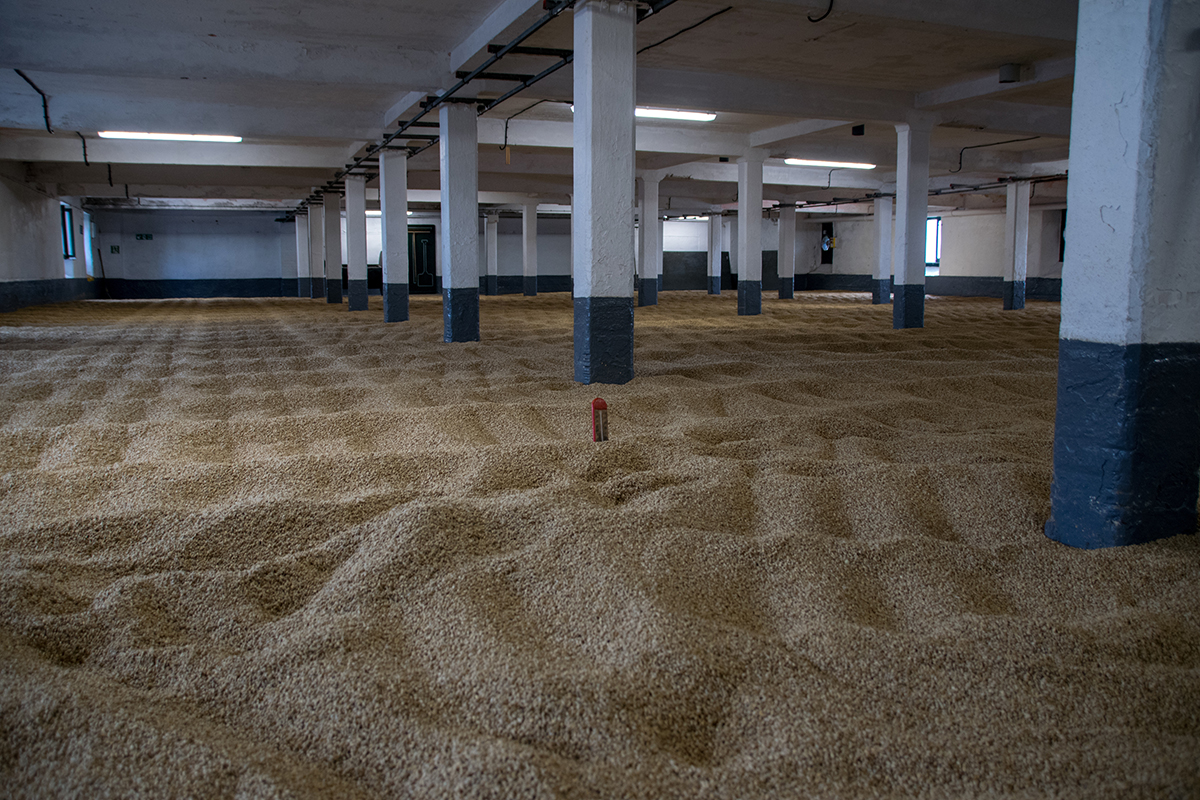Whether you’re a whiskey drinker or a beer drinker, “malted grain” is a term that comes up often. Most often referring to barley, malt is used to make whiskies around the world—from Scotland to Japan. Even here in the US, malt plays a role in our whiskeys. For many distillers nowadays, malted grain comes from a malt house. Here maltsters with expertise in growing, sourcing and malting barley have the ability to produce consistent malt. Moreover, they have the resources for experimentation and innovation.
That includes Great Western Malting in Vancouver, WA (and its handful of additional locations in the US and Canada). First founded in 1934, it is the oldest malting facility in operation in the western US. The company works with barley growers in the Pacific Northwest, supplying distillers there and beyond. Each year, the company produces 348,000 metric tons of malted barley. We talked with Scott Garden, Director of Research and Technical Services at Great Western Malting. He shed some light on the process of malting, why it’s done and what innovation with malted grain looks like.
How Malting Works
Essentially, malt is grain that has been germinated and dried in a precise three-step process. This is done in order to lock in enzymes that are are highly beneficial to the fermentation process. These enzymes are produced as the grain (a seed) begins to grow. Barley, particularly two-row or six-row, is the most commonly malted grain for whiskey. But pretty much any kind of cereal grain can go through a similar process, including wheat and corn.
The first step is steeping, which is exactly what it sounds like. Barley—or other grain types—is soaked in water for a period of time to “wake the barley up,” says Garden. “In essence what we’re doing is starting the growing process of barley. It’s not really much different than the barley kernel would experience [in the ground] to a degree. If you’re planting it in the ground, the first step for kernel growth is hydration.”
The grain spends two to three days going through a period of soaking and air resting. The goal is to raise its moisture content to around 45 percent. After that point, the germination has already begun. The grain is then spread out in a large room, where the barley kernels are regularly turned over. This ensures even aeration and germination of all kernels. Furthermore, the room is kept at a consistent temperature and humidity. Over the course of another four to five days, each kernel begins to produce rootlets and tiny shoots.
“It’s actually gearing itself up to utilize all its storage and turn itself into a plant—but we want to stop that from happening,” says Garden. “We want a limited amount of physical growth, but more importantly we want enzyme production and we want some of what we call modification of that kernel.”
Kilning
To that end, the barley kernels then enter the kiln for drying down to as low as three percent. This halts growth and traps the enzymes and sugar content produced by germination of the grain. The temperature at which this happens and the amount of time the grain spends in the kiln (and then, if warranted, in a subsequent roasting process), all depends on what sort of flavor the brewer or distiller desires.
Different malted barleys can exhibit exceptionally different flavors, from roasty toffee to tropical fruits like bananas and pineapple. A malted barley for a lager-style beer, for example, will be light in color and flavor. Now compare that color and flavor to a malted barley used for an amber ale or porter.
“The kilning process and how we go about the drying is what generates most of the flavors,” says Garden. “Essentially the drying process is what can generate either a lot of different flavors or colors, or we can keep the flavors and colors to a minimum. For certain distiller’s products it is desirable to keep color to a minimum.”

Why Malt Grain?
Though there are only a few steps, it’s imperative to get the timing of each one just right. Also, depending on what type of grain is being used or the effects desired, parameters will vary. The purpose of the malting process is to transform starches into enzymes and sugars that make the grain much more responsive to fermentation. And, of course, it adds a particular flavor to the whiskey mash.
Once the grain arrives at the brewery or distillery, it’s crushed and mixed with water to create a mash. This is where the enzymes produced during the malting process help break down the starches into simple sugars. Then, the spent grain is drained from the liquid and that liquid (called wort) is ready for fermentation.
“When it comes to the way distillers handle the barley malt, there’s some that are looking for the malt to be very high enzyme package,” says Garden. “They’ll add, we’ll say 10 to 15 percent barley malt for its enzyme content and will be adding other cereals [grains] for the starch and other flavors as part of their recipe.”
Garden adds that even small proportions of barley can contribute significantly to the flavor and performance of a whiskey mash.
“Malts can be a driver of some flavor to distilling, although [distillers] do a lot of other things to encourage flavor and finish products with barrel aging,” says Garden. “It depends whether you are an all-malt producer or whether you’re making a product that uses other cereal grains that will determine the types of malt of interest to you.”
Specialized Malts
Garden works at Great Western Malting’s Vancouver, WA, location, which is also home to its Malt Innovation Center (MIC). The facility gives the company the ability to test and develop new products more efficiently in smaller batch sizes. The hope is to find new ideas that may work for brewers, distillers, or in food (think malted milk balls).
“Our innovation is designed to help our customers’ innovation and improve their processes,” says Garden. “We are always looking for ideas.”
For brewing and distilling, the company offers a range of products, from versatile crystal malts to organic malts. There are even “Identity Preserved” malts made with grain sourced from a particular state.
With the growth of the whiskey market—particularly the rise of single malt whiskeys—innovation is especially important for distillers who are looking for a unique flavor profile that also performs well during fermentation. The MIC can work directly with the brewer or distiller to find or develop a malt that serves their needs.
“We’re always looking to ensure that we have varieties that are desirable for everyone, including us, our customers and our growers,” says Garden. “The barley variety has to contribute to the customer’s needs, which are flavor and performance related. They need to generate a certain amount of alcohol at the end of the day as well as a certain flavor profile.”
The Future of Malted Grain
Garden adds that Great Western Malt is also working with a researcher at Oregon State University to develop new winter varieties of barley. It’s also worth noting that in other parts of the United States there’s work being done to develop strains of barley that are more heat tolerant and drought resistant, including Texas A&M’s work with Blacklands Malt. These are qualities that will not only prove useful to distillers in warmer climates, but also may be a boon in regards to climate change.
“We feel that there’s a lot of benefits to being able to have an assortment of spring and winter varieties [of barley] available for our customers,” says Garden. “We do invest a lot in ensuring the sustainability of our business. It’s important to us to be on top of our game and stay engaged and involved to ensure that we are developing … varieties that seem to provide a benefit to all.”
In the end, the kind of innovation that Great Western Malting and other maltsters around the world are spearheading will only benefit what we find on liquor store shelves.
“As the craft beer revolution did, I think that the whiskey industry is evolving and producing many more interesting things for people to try,” says Garden.
Discover more with Distiller
Don’t buy your next bottle without downloading the Distiller app. Search by name or browse by style to read reviews, see flavor profiles, add to your lists and more! Plus when you upgrade to Distiller Pro you can scan bottles on the go and search by flavor to curate spirits to your taste. As an exclusive article discount we’re giving you a free trial month when you use code ONEFREE at checkout.
Discover flavor profiles, read reviews, add your favorites to lists and more! Download here.
With Distiller, you’ll always know what’s in the bottle before you spend a cent. Rate, Review and Discover spirits! Head on over to Distiller, or download the app for iOS and Android today!


